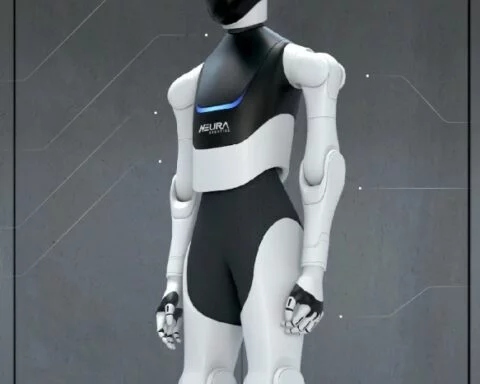Last Updated on July 3, 2024 9:27 am by Laszlo Szabo / NowadAIs | Published on July 3, 2024 by Laszlo Szabo / NowadAIs
Stanford University’s HumanPlus Robot: A Humanoid Observes and Learns Boxing from Human Demonstrations – Key Notes
- HumanPlus is a humanoid robot created by Stanford University researchers.
- The robot can learn tasks such as playing the piano and ping-pong.
- Requires 40 hours of human motion data to learn specific tasks.
- Elon Musk mentions increasing popularity of humanoid robots, like Tesla’s Optimus.
Stanford University’s HumanPlus Robot Copy All Movements
The researchers at Stanford University have created a robot named ‘HumanPlus‘ which has the ability to mimic human movements and learn tasks such as playing the piano and returning a ping-pong ball.
Introduce HumanPlus – Shadowing part
Humanoids are born for using human data. We build a real-time shadowing system using a single RGB camera and a whole-body policy for cloning human motion. Examples:
– boxing🥊
– playing the piano🎹/ping pong
– tossing
– typingOpen-sourced! pic.twitter.com/DQgVDPiNnS
— Zipeng Fu (@zipengfu) June 13, 2024
According to Zipeng Fu, a member of the Stanford team, the humanoid robot employs a complete-body strategy and a sole RGB camera to replicate human movement.
Constructing and educating HumanPlus
According to the study, HumanPlus requires 40 hours of human motion data in order to acquire knowledge and execute a specific task in a sequential manner. Additionally, it is capable of mimicking human actions in real-time by utilizing its camera.
The Unitree H1 robot was utilized as the foundation for the humanoid, while the hands were sourced from Inspire-Robots and the wrists were obtained from a different company. The resulting entity stands at a height of five feet nine inches.
One distinctive feature of the robot is its open source design, allowing for future modifications to its functionality as necessary.
The team of scientists has also made available a GitHub repository for those interested in creating a comparable model themselves. Additionally, the Stanford researchers have shared the data on the costs of the components utilized in HumanPlus:

Obtaining a functional model such as HumanPlus is not inexpensive. According to the team’s estimated figures, the robot was constructed at a cost of approximately $107,945, as reported by Inverse.
Given its ability to replicate and execute a significant number of movements, it is highly probable that it will be among the more cost-effective choices currently offered in the market.
The Age of Humanoid Robots
According to a statement made by Tesla CEO Elon Musk, the use of humanoid robots has become increasingly popular, with his company planning to have over 1,000 of these robots operating in their factories by next year.
According to him, the Optimus robots that he is currently constructing may potentially be available for purchase in the upcoming year, potentially increasing Tesla’s value to $25 trillion.
Musk has previously expressed his belief that Optimus will play a crucial role as Tesla’s primary product. It has been reported that the company currently has two robots operating independently in its primary factory located in the US:
Rundown of what we have achieved since 2018 – under @elonmusk‘s leadership
–
2018
– Hit 5k Model 3/week
– Model 3 becomes best-selling EV in the US
– Giga Nevada reached annual battery production rate of 20 GWh
– Launched Navigate on Autopilot
– Model 3 becomes the best-selling…— Tesla (@Tesla) June 11, 2024
In addition, a college in New York was given a speech for their spring commencement by a robot with human-like features.
In May of this year, D’Youville University in Buffalo hosted a commencement ceremony where Sophia, a well-known AI robot, delivered a speech to a crowd of more than 2,000 people, consisting of graduates, faculty, and families.
Frequently Asked Questions
1. What is the HumanPlus Robot? HumanPlus is a humanoid robot developed by Stanford University researchers that can mimic human movements and learn tasks such as playing the piano and ping-pong.
2. How does the HumanPlus Robot mimic human movements? The HumanPlus Robot uses a single RGB camera and a whole-body policy to replicate human motion in real-time. It requires 40 hours of human motion data to learn and perform specific tasks.
3. What are the key components used to build the HumanPlus Robot? The HumanPlus Robot is built on the Unitree H1 robot platform, with hands sourced from Inspire-Robots and wrists from another company. It stands 5 feet 9 inches tall.
4. How much does it cost to build the HumanPlus Robot? According to Stanford researchers, constructing the HumanPlus Robot costs approximately $107,945. This includes the expenses for all the components and assembly.
5. Can the HumanPlus Robot be modified for other tasks? Yes, the HumanPlus Robot features an open-source design, allowing for future modifications and enhancements. Researchers and developers can access the GitHub repository to create similar models or improve existing functionality.












